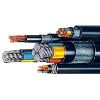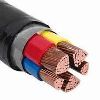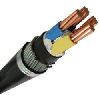






underground cables
Get Price Quote

Armoured Unarmoured Cables
Get Price Quote
RR KABEL brand armoured and unarmoured cables available with copper and aluminium conductor.
Best Deals from Armoured Cables

LDC LP Polycab Armoured Cables
Get Price Quote
100 Square Meter (MOQ)

armoured power cable
Get Price Quote
We have different payment options to choose from as per the convenience of the clients. In the type of operation processed online, the procedure depends on the gateway or processor model; both of them ensure complete security. We assure purchasers that our entire range is subjected to stringent quality policies to meet industry standards.

Armoured Cables
125 - 32,881 Per Meter
100 Meter (MOQ)

Armoured Cable
Get Price Quote
100 Piece (MOQ)

belden cables
Get Price Quote
50 Meter (MOQ)
Profibus Cable: PROFIBUS represents one of, if not the number one, the largest installed bases of fieldbus systems in the world. Using shielded twisted pair constructions, the two main application-specific profiles are PROFIBUS DP, which is optimized for discrete factory automation, and PROFIBUS PA, which is optimized for process automation. Modbus Cable: Modbus has been the standard for interfacing remote I/O and PLCs into the process DCS system for over 20 years. This allows most legacy control systems to interface easily with Modbus

Aluminium Armoured Cable
250 Per Meter

Armored Cable
Get Price Quote
1.1 kV, 1 cores AL CU conductor, PVC insulated, unarmoured cables as per IS 1554 Part – 1. Conductor : AL up to 10 Sq. mm conductor are solid Cl.1 as per IS 8130. And above 10 Sq. mm conductor are stranded round or compact Cl. 2 as per IS 8130 In CU 4 & 6 Sq. mm conductor are solid Cl.1 or stranded Cl. 2 as per IS 8130. 10 Sq. mm & above stranded round or stranded compact Cl. 2 as per IS 8130 Insulation : PVC Type – A, as per IS 5831. (Option : HR PVC Type – C, as per IS 5831) Core Color : Red or yellow or blue or black or natural Outer Sheath : PVC Type ST-1 as per IS 5831. (Option : PVC Type – ST 2 as per IS 5831 FR Type FRLS Type ) Cable Color : Black (Options : Any other color as per requirement)

Cathodic Protection Cable
150 Per Meter
100 Meter (MOQ)

Polycab Armoured Cable
500 Per Meter

ALUMINIUM UNARMOURED CABLE
Get Price Quote

PVC Insulated Armored Cable
90 Per Meter

LT PVC Armoured / Un-Armoured Power aND Control Cables
Get Price Quote
Armoured / Un-Armoured Power & Control Cables DP DEELUX POWERCAB is manufacturer of a wide range of Armoured Cables, Armoured Power Cables, Armoured Electrical Cables, PVC Armoured Cables and XLPE Armoured Cables. XLPE means cross-linked polyethylene or vulcanized polyethylene. The basic material is low density polyethylene. Polyethylene is a thermoplastic material consisting of long chain of hydrocarbon molecules. At elevated temperatures these molecules tend to move relative to one another so that the material becomes increasingly deformable and will eventually melt at the temperature around 110°C. The process of rubber the polyethylene molecules can be cross-linked. The process of cross-linking or vulcanization consists of producing chemical bonds at interval between the long molecular chain to give a ladder effect which prevents slippage between molecules as a result of cross-linking the material becomes heat resistant and does not soften at higher temperatures. Further it has better resistance to stress cracking and good resistance to ageing in hot air. With the change of structure there is no adverse effect on electrical properties. CONDUCTOR The most acceptable metals are copper and Aluminium due to their higher conductivity & ductility.As Copper has got higher affinity for sulphur, it corrodes in the atmosphere where sulphur fumes are present. In these conditions tinned copper should be used. Aluminium oxide film which is always present on aluminum conductor surface acts as barrier and it protects the Aluminum conductor from corrosion in fumes laden atmosphere. CONDUCTOR CONSTRUCTION The most economical construction for conductor is solid conductor i.e. conductor made of one single wire. As the area conductor increases, solid conductor becomes stiffer and hence difficult to handle in this case stranded construction is adopted. Here the conductor is made of number of strands. This construction provides more flexibility. Where crimping of lugs is required, the conductor has to be of stranded construction only. To economies in insulating material, weight and overall diameter, shaped conductors are employed in bigger sized cables. Here the stranded conductor is shaped in to a segment of a circle so that when all the cores are laid, they form a complete circle. These segments are identified as 2 Core- 180 degrees, 3 Core- 120 degrees, 4 Core- 90 degrees, 3.5 Core- 100/60 degrees. I.S.1554 permits solid conductor construction up to 10 sq.mm in aluminium and up to 6 sq.mm in copper. It permits the use of shaped conductors for size from 16sq.mm onwards. INSULATION The PVC covering over conductor is called insulation and is provided by extrusion process only. The insulated conductor is called core.I.S.:1554 permits two types of PVC insulation as follows: 1)Insulation with type A PVC Compound as per IS: 5831 which is suitable for 70°C continuous operation. 2) Insulation with type C PVC Compound as per IS: 5831 which is suitable for 85°C continuous operation. LAYING UP The cores are laid up with suitable lay. The final layer always has a right hand lay i.e. if you look along the cable, the cores move to your right hand. INNER SHEATH Inner sheath is provided over the laid up cores. It is provided to give circular shape to the cable and it provides bedding for the armouring. I.S. 1554 permits following two methods of applying the inner sheath of any thermoplastic material i.e. PVC, Polyethylene, etc. EXTRUDED INNER SHEATH:Here the inner sheath is provided by extrusion of Thermoplastic over the laid up cores. This type of Innersheath is generally provided in cables having round cores i.e. in control cables and power cables upto 10 sq.mm sizes. This type of the inner sheath also acts as a water barrier between cores and outer sheath. Is case of a puncture in the outer sheath the water cannot reach to the cores and hence we recommend that cables for outdoor underground uses should have extruded inner sheath. TAPPED INNER SHEATH:Here the inner sheath is provided by wrapping a thermoplastic tape over the laid up cores. It is generally employed in cables having sector shaped cored i.e. multi core cables of 16sq.mm and above. This method saves a process and hence manufactures always provide this type of inner sheath unless the purchase specifications ask for extruded inner sheath. ARMOURING In case of armoured cables, generally galvanized steel wire / strip is provided over the inner sheath is multi core cables and Aluminium Round wire or Aluminium strip over the insulation in single core cables. It provides mechanical protection inside cores and it carries earth return current in case of short circuit of a core with armour. As per I.S. 1554 (Part-1) 1988, round wire armouring is provided in cable, where calculated diameter under armour is up to 13 mm. Above this the armouring is either with round wire or strip of size 4 mm 0.80 mm. As strip construction is economical, the manufactures always provide steel strip armouring unless wire armouring is specially specified. In long run of cables and in case of mines, round wire armouring is must, as strip construction provide higher resistance to earth fault current and sometimes this current may not be sufficient to operate the circuit breaker in case of earth fault. In mines, the resistance of the armour in no case should exceed the resistance of the main core by more than 33% for safety reasons. To achieve this, sometimes tinned hard drawn copper wires are required to be used along with galvanized steel wires. Sometimes two layers of Round steel wire or Steel Strip are applied in opposite direction with barrier tape in between are provided to give extra protection. In case of single core for use in AC circuits, the material for armouring has to be nonmagnetic, as in this case the return current is not passing through the same cable and hence it will not cancel the magnetic lines produced by the current. These magnetic lines which are oscillating in case of AC current will give rise to eddy current in magnetic armouring and hence armouring will become hot, and this may lead to the failure of the cable. Generally hard drawn aluminium wires / strip are used for armouring in this case. OUTER SHEATH The PVC covering the armouring in case of armoured cables and over the inner sheath in case of un-armoured cables is called outer sheath. I.S. 1554 specifies nominal and minimum thickness of outer sheath for UN –armoured cables and only minimum thickness of outer sheath for armoured cables. It permits the following types of outer sheath PVC compounds. Outer sheath with type ST1 PVC compound as per IS: 5831, which is suitable for 70°C continuous operation. Outer sheath with type ST2 PVC compound as per IS: 5831, which is suitable for 85°C continuous operation. PVC has got fire retardant properties due to its halogen content. The fire in the cable gets extinguished immediately on removal on the fire source. In the modern Power, Chemical, Fertilizer and Cement plants many PVC cables are bunched in the cable shaft or on cable trays. In case of fire in these cables, the fire becomes self sustaining. Moreover due to the burning of PVC a dense corrosive smoke is emitted which makes fire fighting very difficult, due to poor visibility and toxic nature of the smoke. HCL content of the smoke, not only damages other costly equipment lying nearby, but also penetrates the RCC and corrodes the steel reinforcement. Due to this there is an extensive to the property. To overcome these deficiencies FRLS i.e. Fire Retardant Low Smoke PVC was developed. If required, we can provide Fire Retardant Low Smoke (FRLS) PVC Inner Sheath and / or outer sheath. This PVC compound, apart from meeting the requirements of Type ST2 as per IS-5831, has got better fire retardant properties and it emits lower smoke and acid fumes when it catches fire.

aluminium armoured cables
Get Price Quote
We have in our range HT XLPE cables of GLOSTER, NICCO, INCAB and POLYCAB makes from 25 sq mm to 400 sq mm in 3 core and 240 sq mm to 800 sq mm in single core for 3.3 Kv, 6.6 Kv, 11 Kv, 22 Kv and 33 Kv grade, suitable for both earth and unearth system. These cables are available with PVC / Extruded PVC inner sheathing, flat steel strip / round wire armouring, PVC / FRLS PVC inner and outer sheath and with oxygen index. These cables are manufactured as per IS:7098 / II and carries ISI mark

6 Core Armoured Fiber Optic Cable
16 Per Meter

Armoured Coaxial Cables
Get Price Quote
The Armoured Coaxial Cables are preferred for areas where protection is required against mechanical damages. These are preferred for underground installations. The armor is a layer of overlapping metal, mostly steel tapes or wires that form the outermost metallic layer of a cable in order to protect the cables’ waterproof sheet. This armor layer is itself protected against corrosion with a protective sheath. Overview Technical Information Technical Drawing Spectrum cable-Tech specializes in the production and distribution of high-end Co-axial Cables in the industry. The digital co-axial cables that we make provide as higher capacity than the copper or twisted-pair cables. RF co-axial cables consist of two wires, first a copper wire that is surrounded by an insulator, the second is surrounded by a metallic cylinder called the shield. The use of co-axial cable reduce electrical interference and are very effective for carrying TV and other communication signals. In order to meet various demands of various industrial applications, these cables are made available in several technical specifications. Range: RG 6, RG 11, RG 59 (Armoured & Unarmoured) Unarmoured Coaxial Cables The Unarmored Coaxial Cables are demanded for cable TV industry, computer networking, conduit pathways and in public places. This cable is constructed from solid annealed bare copper conductor polyethylene insulated shielded with polyester backed aluminum tape. It has additional shielding with fine aluminum braid protected with polyester tape wrapping and sheathed with PVC. The wire is mainly installed underground and does not require protection against mechanical damages. The electromagnetic field is locking up inside the crosssection of a cable. These can be easily installed in small spaces and buried underground. Features: Shielded with metallic foil on both sides of supporting polyester Reduced incidences of circuit disruption due to rodents Protects against mechanically abusive applications Eliminates the need for multiple cable types of installation Customized designs reduces cable type for installation Customized design Reduces cable inventory requirements Installs faster Easier than EMT conduit & conventional wire Flame retardant Thick, flexible metallic armor Application: High quality RG type coaxial cables. 75 ohms is suitable for many applications, including low power video, video signal and broadband signal Armoured Coaxial Cables The Armoured Coaxial Cables are preferred for areas where protection is required against mechanical damages. These are preferred for underground installations. The armor is a layer of overlapping metal, mostly steel tapes or wires that form the outermost metallic layer of a cable in order to protect the cables’ waterproof sheet. This armor layer is itself protected against corrosion with a protective sheath. Features: Reduces the need of multiple cable types of installation Reduces cable inventory requirements Installs faster Customized designs Application:High quality RG type coaxial cables. 75 ohms is suitable for many applications, including low power video, video signal and broadband signals.

Aluminium Armoured Cable
90 Per Meter

aluminum armoured cables
38 Per Meter

pvc insulated armoured cables
Get Price Quote
pvc insulated armoured cables, PVC Insulated Aluminum Cable, Elevator Cable